英文听课记录表
英语听课记录(完整版)
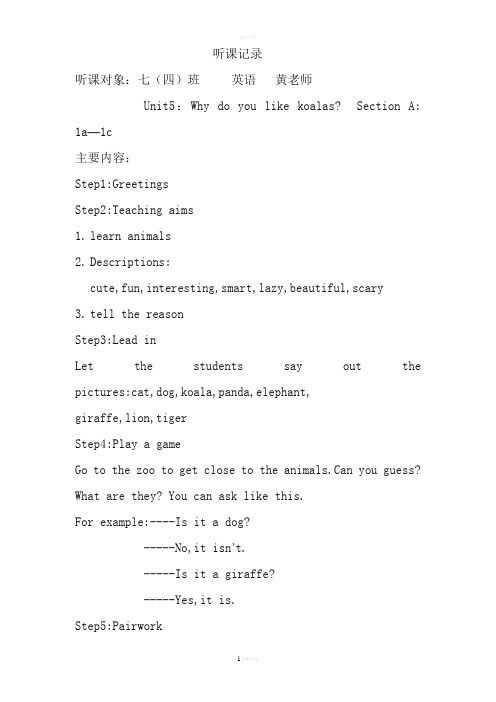
听课记录听课对象:七(四)班英语黄老师Unit5:Why do you like koalas? Section A: 1a—1c主要内容:Step1:GreetingsStep2:Teaching aims1.learn animals2.Descriptions:cute,fun,interesting,smart,lazy,beautiful,scary3.tell the reasonStep3:Lead inLet the students say out the pictures:cat,dog,koala,panda,elephant,giraffe,lion,tigerStep4:Play a gameGo to the zoo to get close to the animals.Can you guess? What are they? You can ask like this.For example:----Is it a dog?-----No,it isn’t.-----Is it a giraffe?-----Yes,it is.Step5:Pairwork(practice the dialogue with the pictures on the blackboard)--What animals do you like?-- I like pandas.-- Why do you like pandas?-- Because they are cute. How about you?-- I like pandas , too.-- Oh , let’s see the pandas first!-- That sounds good!-- OK. Let’s go!Step6:Do 1a(Match and read the dialogue)Step7:Listen 1bStep8:Read 1cStep9:Do the exerciseStep10:Make a conclusion.(Just as the teaching aims)1.Animals2.Descriptions: cute fun interesting smart lazy beautiful scary(a little=kind of very)3. Make a dialogue4. 重点语法:▲ why----because▲let + V原形▲ kind of= a little 有点儿▲ a kind of 一种▲ kinds of 多种多样的Step11:Learn more meaning from this lesson from a piture. (Animals are our friends.We should treat themwell.---“Love animals ,Love ourselves!”)Step12:HomeworkRecite the words in this unit and do the exercise book in period 1.重点与难点:1.重点:The words of animals and descriptions(cute,fun,interesting,smart,lazy,beautiful,scary) 2.难点: Pairwork(practice the dialogue with the pictures on the blackboard 评:这堂课的教学中黄老师用的教法有:1.使用多媒体;2.制作有关动物的卡片;3.用Pairwork的方法来练习对话,从而进一步的掌握动物和描述动物的形容词;4.练习题紧跟,及时巩固本节所学知识点。
英语English_听课记录表

听课记录表听课人:王佳欣单位:重庆师范大学时间2013 年11月17 日星期四上午第二节地点璧山中学任课教师张老师课题名称Unit4 A Night the Earth Didn’tSleep班级高一(4)班高中一年级英语下册Unit 4 A Night the Earth Didn’t Sleep?听课记录教学过程:StepⅠ.pre-readingAsk the students read the text loudly in 10 minutesAsk students a QuestionQuestion:Have you known some words about disasters?And show them some pictures about natural disasters.Show the key vocabulary words on the screenRead these words and make students repeat twice timesThe key vocabulary words are follows:tsunami 海啸flood 洪水drought 干旱mudflow 泥石流hurricanes 飓风earthquake 地震Ask students a questionQuestion: how many several terrible earthquakes do you know in the world? And The teacher guide the students to talk about WenChuan Earthquake tolead to the topic.StepⅡ.1aT:please look at the TVs in the illustration.In picture a ,we can see a person playing baseball.It is a sports show.Now you can name the other kinds of TV shows by yourselvesMake a students read these words loudlyAt the same time ,write them on the blackboardStepⅢ.1bCall students attention to the words and smiling and frowning faces in the box.Play the recording the first time.Students only listenPlay the recording again.Students listen and write the letters of a TV show In each blank.Then.Check the answersAnswers:1.b2.a3.c4.d5.eTapescript:Jack: What do you think of soap operas,Mark?Mark: I don’t like them .Jack: What do you think of game shows ?Mark: I love themJack: What do you think of sitcoms?Mark: sitcoms?Mmm.I don’t mind them .Jack: What do you think of sports shows ?Mark: I like themJack: What do you think of talk shows ?Mark: talk shows ?I can’t stand them.StepⅣ.1cAllow students one minute to read the TV shows in 1a again .Invite a pair of students to read the sample conversation to the class .T:Please work in pairs .One student asks the question "What do you think of talk shows/sitcom ……"Get students to work in pairs .Ask several pairs to share their conversation with the class .StepⅤ.SummaryT:In this class ,we’ve learned names of some TV shows first ,which are talk Show,soap opera ,sports show ,sitcom and game show .Then we’ve done much Listening and oral practice using the target language What do you think of sitcoms? I love them .StepⅥ.HomeworkT:After class ,recite the spelling of the key words and the conversation in 1cStepⅦ.Blackboard Design。
初中英语听课记录表

初中英语听课记录表日期地点类型级别组织者活动内容06.7.20宁教院讲座市级师训处做一名智慧的教师06.7. 20宁教院讲座市级师训处一堂好课的研究06.7. 30宁教院讲座市级师训处英语教学的互动模式06.8. 2宁教院讲座市级师训处教师礼仪06.8. 3宁教院讲座市级师训处班级文化的建设与学生健康发展06.9. 23本校公开课组内英语组Book1 Unit 2 Is thisyour pencil?06.9. 25本校公开课组内英语组Book 2Unit4第一课时06.10 .15本校公开课组内英语组Book 3Unit6第一课时06.11 .20湖州南浔锦绣实验中学探究课市级区教研室Book2Unit9 When was heborn?06.11 .25本校公开课组内英语组Book2Unit10I’m going to be abasketball player.06.12 .23本校公开课组内英语组Final revision英语组06 学年第 2 学期教研活动记录表日期地点类型级别组织者活动内容07.3.28本校精品课送教区级区教研室Book2Unit3 Whatare you doing forvacation?07.4.15本校讲座校内校办班主任的艺术07.5.11本校教师论坛校内校办关于说课07.5.25本校教师论坛校内校办案例的撰写07.6.8本校公开课校内教研组Book2 Unit9第一课时07.6.29本校公开课校内教研组Review of Book1<下>07.7.18宁教院讲座市级师训处谈谈英语教师的基本素质07.7.19宁教院讲座市级师训处插花的艺术07.7.20宁教院讲座市级师训处信息技术在教学中的运用英语组07 学年第1学期教研活动记录表日期地点类型级别组织者活动内容9月4日研讨组内陈凤珠制订本学期教学计划9月20日宁波八中听课市级市教研室初中英语7年级“Go forit!”(Section A &B) 课堂教学研讨会10月16日实验中学听课区级区教研室区中学英语青年教师课堂教学系列活动一10月23日集体备课组内陈凤珠集体备课10月30日听课组内陈力7上Unit 711月13日孔浦中学听课区级区教研室区中学英语青年教师课堂教学系列活动二11月27日听课组内俞位芬8上Unit 1012月4日三江中学听课区级区教研室八年级课堂教学观摩研讨活动12月7日听课组内郑竹亚8上Unit 1212月11日庄桥中学听课区级区教研室区中学英语青年教师课堂教学系列活动四12月18日听课组内陈凤珠初三复习课英语组07 学年第2学期教研活动记录表日期地点类型级别组织者活动内容08年2月26日研讨组内陈凤珠制订本学期教学计划08年3月25日宁波七中研讨会市级市教研室宁波大市初三年级英语复习研讨会4月8日听课组内贺凤英形容词比较级的复习4月11日宁波九中听课区级区教研室区初中英语课堂教学“新生代”评比5月8日至9日奉化锦屏中学听课市级市教研室市初中英语“新生代”课堂教学展示评比活动4月15日洪塘中学研讨会区级区教研室初三英语复习研讨活动6月10日听课组内叶剑锋初三复习课7月1日研讨会组内陈凤珠期末教学工作总结英语组08学年第 1 学期教研活动记录表日期地点类型级别组织者活动内容9 .3教研室研讨区级教研室本学期教学工作安排9 .10本校研讨校级教研组长本校教学工作安排9 .24本校集体备课校级备课组长Go For It! 七年级上册Unit TwoSection B1 0.7江北实验听课区级教研室Go For It!七年级上册Unit 6Section BGo For It!七年级上册Unit 5 Section A1 0.14本校听课校级陶竟楠七年级上册Unit 3 Section A1 0.21本校集体备课校级教研组长初二学生英语讲故事比赛1 0.28区教研室竞赛区级教研室学生英语能力展示1 1.11本校集体备课校级教研组长教学五认真检查1 1.25本校听课校级陈力Unit 8Section A1 2.2本校听课校级叶剑峰Unit 9Section A1 2.9三江中学阶梯教室听课区级教研室一、Unit 11Could you pleaseclean your room?Section A二、Go For It!八年级上Unit 11Could you pleaseclean your room?Section B 孔浦中学郎敏老师三、反思与点评1 2.23本校听课校级郑竹亚Go For It 九年级Unit 11Section A1 2.30本校集体备课校级备课组长Go For It 复习课1 .6本校听课校级贺凤英Go For It 八年级 Unit12 复习1 .13本校集体备课校级教务处教学常规检查英语组08学年第 2 学期教研活动记录表日期地点类型级别组织者活动内容2.1 7教研室研讨区级教研室本学期教学工作安排2.2 4本校研讨校级组长本校教学工作安排3.3本校集体备课校级组长ThreeSection B3.5 -6洪塘中学听课区级教研室七年级下册八年级下册九年级3.1 7国际学校听课市级教研室完形填空解题、表达研讨课、考试说明解读。
四年级英语听课记录

四年级英语听课记录一、听课基本信息。
1. 听课日期:[具体日期]2. 授课教师:[教师姓名]3. 授课班级:四年级[X]班。
4. 授课内容:Unit [X] Let's talk。
二、教学过程。
(一)导入(5分钟)1. 教师通过播放一段与本单元话题相关的英语动画视频(关于动物在农场里的活动)来吸引学生的注意力,视频时长约2分钟。
2. 播放结束后,教师提问学生在视频中看到了哪些动物,学生们积极举手回答,如“cat”“dog”“cow”等。
教师对学生的回答给予肯定和表扬,并用简单的英语句子重复学生的答案,如“Yes, we can see a cat. It's very cute.”(二)知识呈现(15分钟)1. 教师展示课本上的对话图片,引导学生观察图片中的人物和场景,并用英语简单描述,例如:“Look at this picture. There are two children. They are on the farm.”2. 教师开始逐句朗读对话,每读完一句,就用简单的英语解释句子的含义,如:“What are these? They are sheep.(指着图片中的绵羊说)”。
在这个过程中,教师注重对重点单词(如“sheep”“horse”等)的发音纠正,让学生们跟读几遍。
3. 教师邀请几位学生尝试朗读刚刚学过的句子,其他学生认真倾听并指出朗读中的错误。
对于读得好的学生,教师给予小贴纸奖励。
(三)练习巩固(20分钟)1. 教师将学生分成小组,进行对话练习。
每个小组的成员分别扮演对话中的角色,练习课本上的对话内容。
在学生练习过程中,教师巡视各个小组,及时给予指导和帮助,纠正学生的发音和语法错误。
2. 小组练习结束后,教师挑选几个小组上台进行对话展示。
展示结束后,其他小组的学生可以进行评价,如“Your pronunciation is very good.”或者提出建议,如“You should speak a little louder.”教师根据学生的评价和建议进行总结,并再次强调对话中的重点内容。
初中英语听课记录表

初中英语听课记录表日期地点类型级别组织者活动内容06.7.20宁教院讲座市级师训处做一名智慧的教师06.7.2 0宁教院讲座市级师训处一堂好课的研究06.7.3 0宁教院讲座市级师训处英语教学的互动模式06.8.2宁教院讲座市级师训处教师礼仪06.8.3宁教院讲座市级师训处班级文化的建设与学生健康发展06.9.2 3本校公开课组内英语组Book1 Unit 2 Isthis your pencil?06.9.2 5本校公开课组内英语组Book 2Unit4第一课时06.10. 15本校公开课组内英语组Book 3Unit6第一课时06.11. 20湖州南浔锦绣实验中学探究课市级区教研室Book2Unit9???? Whenwas he born?06.11. 25本校公开课组内英语组Book2Unit10????? I’m going to be abasketball player.06.12. 23本校公开课组内英语组Final revision英语组?06?学年第?2?学期教研活动记录表日期地点类型级别组织者活动内容07.3.28本校精品课送教区级区教研室Book2Unit3????? What areyou doing forvacation?07.4.15本校讲座校内校办班主任的艺术07.5.11本校教师论坛校内校办关于说课07.5.25本校教师论坛校内校办案例的撰写07.6.8本校公开课校内教研组Book2 Unit9第一课时07.6.29本校公开课校内教研组Review ofBook1<下>07.7.18宁教院讲座市级师训处谈谈英语教师的基本素质07.7.19宁教院讲座市级师训处插花的艺术07.7.20宁教院讲座市级师训处信息技术在教学中的运用?????? ????英语?组?07?学年第?1学期教研活动记录表日期地点类型级别组织者活动内容9月4日?研讨组内陈凤珠制订本学期教学计划9月20日宁波八中听课市级市教研室初中英语7年级“Go for it!”(Section A& B) 课堂教学研讨会10月16日实验中学听课区级区教研室区中学英语青年教师课堂教学系列活动一10月23日?集体备课组内陈凤珠集体备课10月30日?听课组内陈力7上Unit 711月13日孔浦中学听课区级区教研室区中学英语青年教师课堂教学系列活动二11月27日?听课组内俞位芬8上Unit 1012月4日三江中学听课区级区教研室八年级课堂教学观摩研讨活动12月7日?听课组内郑竹亚8上Unit 1212月11日庄桥中学听课区级区教研室区中学英语青年教师课堂教学系列活动四12月18日?听课组内陈凤珠初三复习课?英语?组?07?学年第?2学期教研活动记录表日期地点类型级别组织者活动内容08年2月26日?研讨组内陈凤珠制订本学期教学计划08年3月25日宁波七中研讨会市级市教研室宁波大市初三年级英语复习研讨会4月8日?听课组内贺凤英形容词比较级的复习4月11日宁波九中听课区级区教研室区初中英语课堂教学“新生代”评比5月8日至9日奉化锦屏中学听课市级市教研室市初中英语“新生代”课堂教学展示评比活动4月15日洪塘中学研讨会区级区教研室初三英语复习研讨活动6月10日?听课组内叶剑锋初三复习课7月1日?研讨会组内陈凤珠期末教学工作总结?英语组?08学年第?1?学期教研活动记录表日期地点类型级别组织者活动内容9 .3教研室研讨区级教研室本学期教学工作安排9 .10本校研讨校级教研组长本校教学工作安排9 .24本校集体备课校级备课组长Go For It! 七年级上册Unit TwoSection B1 0.7江北实验听课区级教研室Go For It!七年级上册Unit 6 SectionBGo For It!七年级上册Unit 5 SectionA1 0.14本校听课校级陶竟楠?七年级上册Unit 3 Section A1本校集校教初二学生英语0.21体备课级研组长讲故事比赛1 0.28区教研室竞赛区级教研室学生英语能力展示1 1.11本校集体备课校级教研组长教学五认真检查1 1.25本校听课校级陈力Unit 8 SectionA1 2.2本校听课校级叶剑峰Unit 9 SectionA1 2.9三江中学阶梯教室听课区级教研室一、Unit 11Could you pleaseclean your room?Section A二、Go For It!八年级上Unit 11Could you pleaseclean your room?Section B孔浦中学郎敏老师三、反思与点评1 2.23本校听课校级郑竹亚Go For It 九年级Unit 11 SectionA1 2.30本校集体备课校级备课组长Go For It 复习课1 .6本校听课校级贺凤英Go For It 八年级Unit12 复习1 .13本校集体备课校级教务处教学常规检查?英语组?08学年第?2?学期教研活动记录表日期地点类型级别组织者活动内容2.1 7教研室研讨区级教研室本学期教学工作安排2.2 4本校研讨校级组长本校教学工作安排3.3本校集体备课校级组长?Three SectionB3.5 -6洪塘中学听课区级教研室七年级下册八年级下册九年级3.1 7国际学校听课市级教研室完形填空解题、表达研讨课、考试说明解读。
初中英语听评课记录表
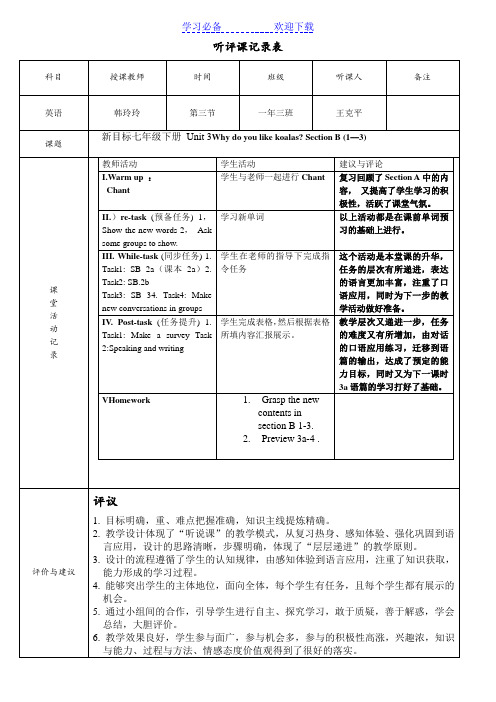
听评课记录表科目授课教师时间班级听课人备注英语韩玲玲第三节一年三班王克平课题新目标七年级下册Unit 3Why do you like koalas? Section B (1—3)课堂活动记录教师活动学生活动建议与评论I.Warm up :Chant学生与老师一起进行Chant复习回顾了Section A中的内容,又提高了学生学习的积极性,活跃了课堂气氛。
II.)re-task (预备任务) 1,Show the new words 2,Asksome groups to show.学习新单词以上活动都是在课前单词预习的基础上进行。
III. While-task (同步任务) 1.Task1: SB 2a(课本2a)2.Task2: SB.2bTask3: SB 34. Task4: Makenew conversations in groups学生在老师的指导下完成指令任务这个活动是本堂课的升华,任务的层次有所递进,表达的语言更加丰富,注重了口语应用,同时为下一步的教学活动做好准备。
IV. Post-task (任务提升) 1.Task1:Make a survey Task2:Speaking and writing学生完成表格,然后根据表格所填内容汇报展示。
教学层次又递进一步,任务的难度又有所增加,由对话的口语应用练习,迁移到语篇的输出,达成了预定的能力目标,同时又为下一课时3a语篇的学习打好了基础。
VHomework 1.Grasp the newcontents insection B 1-3.2.Preview 3a-4 .评价与建议评议1. 目标明确,重、难点把握准确,知识主线提炼精确。
2. 教学设计体现了“听说课”的教学模式,从复习热身、感知体验、强化巩固到语言应用,设计的思路清晰,步骤明确,体现了“层层递进”的教学原则。
3. 设计的流程遵循了学生的认知规律,由感知体验到语言应用,注重了知识获取,能力形成的学习过程。
人教版七年级英语听课记录

人教版七年级英语听课记录一、听课基本信息。
1. 听课日期:[具体日期]2. 授课教师:[教师姓名]3. 授课班级:七年级[X]班。
4. 授课内容:Unit [X] Section A。
二、教学过程。
(一)导入(5分钟)1. 教师通过展示一些与本节课话题相关的图片(如家庭成员的照片),引起学生的兴趣。
- 教师问:“What can you see in these pictures?”引导学生用简单的英语单词回答,如“father”“mother”等。
- 大部分学生积极参与回答,课堂气氛活跃起来。
2. 教师接着播放了一段简短的关于家庭介绍的视频片段,视频中有简单的英语对话。
- 播放完视频后,教师提问:“What did you hear in the video?”有部分学生能够说出一些视频中的单词,如“family”“love”等。
(二)知识讲解(20分钟)1. 词汇学习。
- 教师在黑板上列出了本节课的重点词汇,如“grandfather”“grandmother”“parent”“sister”“brother”等。
- 教师先领读每个单词,读得清晰、缓慢,并且强调了单词的重音和发音规则。
例如,在教“grandfather”时,强调“grand”中的/a:/音和“father”的正常发音。
- 然后让学生跟读,采用全班跟读、小组跟读、个别学生跟读的方式,确保每个学生都有机会练习发音。
- 为了帮助学生记忆单词,教师采用了一些记忆方法。
如对于“parent”,教师解释说“p - a - r - e - n - t,它可以表示父亲或者母亲,是父母双亲中的一个”。
2. 句型讲解。
- 教师引出本节课的重点句型“This is my...”和“These are my...”。
- 在黑板上写出例句“This is my father.”和“These are my parents.”,并详细讲解了“this”和“these”的用法区别。
英语听课记录表
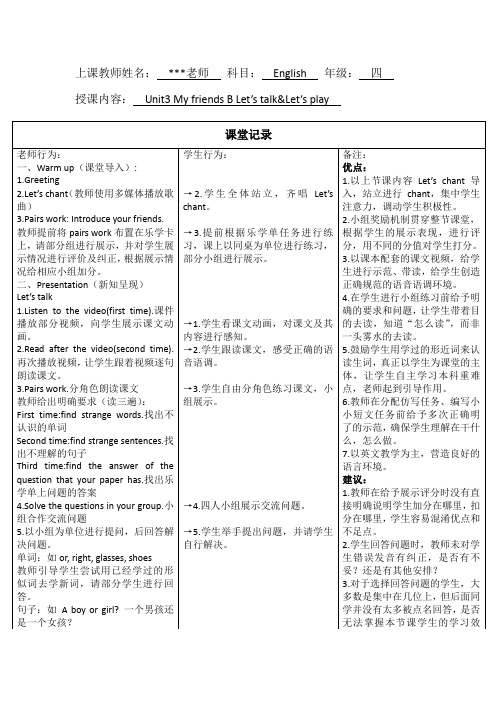
三、结课
学生行为:
→2.学生全体站立,齐唱Let’s chant。
→3.提前根据乐学单任务进行练习,课上以同桌为单位进行练习,部分小组进行展示。
→1.学生看课文动画,对课文及其内容进行感知。
→2.学生跟读课文,感受正确的语音语调。
→3.学生自由分角色练习课文,小组展示。
2.小组奖励机制贯穿整节课堂,根据学生的展示表现,进行评分,用不同的分值对学生打分。
3.以课本配套的课文视频,给学生进行示范、带读,给学生创造正确规范的语音语调环境。
4.在学生进行小组练习前给予明确的要求和问题,让学生带着目的去读,知道“怎么读”,而非一头雾水的去读。
5.鼓励学生用学过的形近词来认读生词,真正以学生为课堂的主体,让学生自主学习本科重难点,老师起到引导作用。
同时怎么来读每个句子,每个句子都以学生作为主体,让学生来翻译。
6.仿写句子,结合实际,描写同学。
a.教师给出示范,多次
b.Pairs work:同桌间进行展示交流,教师给予单独提点
C.教师请几组同学展示,并给予点评纠错,根据表现给分
7.回归课文,Pairs work,练习课文朗读,后教师请几组同学展示,并对其表现给小组加相应分数
4.Solve the questions in your group.小组合作交流问题
5.以小组为单位进行提问,后回答解决问题。
单词:如or, right, glasses, shoes
教师引导学生尝试用已经学过的形似词去学新词,请部分学生进行回答。
句子:如A boy or girl?一个男孩还是一个女孩?
教师提前将pairs work布置在乐学卡上,请部分组进行展示,并对学生展示情况进行评价及纠正,根据展示情况给相应小组加分。
英语听课记录

英语听课记录文档编制序号:[KK8UY-LL9IO69-TTO6M3-MTOL89-FTT688]听课记录一:Lesson type: WritingTeaching objectives:By the end of this lesson, students will be able to…1. Language skills:1) Speaking: talk about what pollutions the earth has, why there are pollutions on earth and how to protect the earth;2) Writing: write an article on How to protect the earth using expressions they have learnt in this lesson.2. Language knowledge:1) Vocabulary: identify some new words and expressions: pollute, pollution, fewer and fewer, waste, stop doing sth., less, save, link words(and, then, when…)2) Topic: discuss daily and environmental pollution by using expressions from the text.3. Affect:Be aware of the importance of environmental protection and express their opinions on environmental pollution.4. Learning strategies:Improve writing evaluating fellow student’s work.Teaching focus:Help students to use the phrases and expression to write the article.Teaching procedure:Step 1: Lead in1. Greet the students.2. Ask the students and help them to recall what they havelearnt in the last lesson.3. Show pictures of the beautiful earth and the polluted earth, ask the students why the earth is dirty now, and lead in one of the problems “pollution”.Step 2: Presentation1. Ask the students what problems do the earth has (problems) and what bad things do students do to the earth (reasons).2. Show new words and phrases relevant to these questions.Step 3: Discussion1. Ask the students to discuss in groups what they can do to protect the earth (solutions).2. Ask the students to share their thoughts.Step 4: SummarySum up the solutions by showing pictures and phrases,preparing students for writing.Step 5: Writing1. Show the writing task and give a writing pattern to the students.2. Ask students to take out notebooks to write.Step 6: Evaluation1. Introduce the Evaluation Form in which there are rules of giving points.2. Ask the students to exchange their articles with their partners and check each other’s.3. Pick up some students to show their articles through OHP, ask them to read out the articles.4. Evaluate the articles with the whole class according to the Evaluation Form. (Class Conferencing)Step 7: SummarySum up the key words and phrases in this writing class.Step 8: Assignment1. Finish the exercise on the paper.2. Recite the words.Advantage and disadvantage:1. Advantages:1) Use English throughout the lesson;2) Give positive responses to students;3) Carry out the procedures both clearly and coherently;4) Have a good control of time;5) Give out the instructions in a brief and clear way;6) The writing part is closely related to life;7) The pictures of the slide are approachable in daily life;8) The words, phrases and sentences mentioned are useful for writing.2. Disadvantages:1) Lack of smile;2) Ignore students’ creativity in writing;3) The writing form should not be given to students at the very beginning, which limits students’ expression.听课记录二:Lesson type: GrammarTeaching objectives:By the end of this lesson, students will be able to…1. Language Knowledge:Grammar:1) know the meaning of the comparative of adjectives;2) understand the usage of the comparative of adjectives.2. Language skills:1) use the comparative of adjectives to compare two or more persons and objects;2) use language through discovering language and learning language;3. Affect:1) develop team spirit;.2) develop the awareness of helping each other.Teaching focus:Help students to discover language, learn language and use language.Teaching procedure:Step 1: Warming up and lead-in1. Listen to a song, fill the blanks and guess the title ofthe song.2. Pair work: discuss and check the answers quickly.3. Lead in the Grammar, The comparative of adjectives.Step 2: Discovering language1. Group work: write down two sentences with the comparativeof adjectives from the text quickly and speak out the features of the sentences.2. Pick up several groups to show their sentences; whole class read them loudly.3. Circle the features (bigger, smaller, better…), ask students to tell what it is (Ss: The comparative of adjectives). Step 3: Learning languageTask 1:1. Show a picture of Grace, ask students to describe her (Ss: …/T write down the adjectives on blackboard).2. Ask the students how to change these adjectives into comparative forms (Ss: …/T write down the comparative forms on blackboard).Task 2: Work out the rules1. Look at the adjectives and their comparative forms (according to 5 rules), try do find out the rules.2. Show the rules of the comparative forms in a table (systematized), ask students to fill the table and write down examples for each rule (time limit, T: giving stars as prizes); ask different students to show their answers.Task 3:1. Finish the exercise from P39 to P40 (time limit, T: ask the slowest students to show their answers); pair work: discuss and check the answers;2. Whole class read it through.Step 4: Using language1. Show pictures of iphone5 and iphone6 with their detailed information (Height/ Width/ Depth/ Weight/ Price) and a photo of a family.2. Pair work: ask students to introduce these two phones (giving tips for adjectives that can be used; can imitate the dialogue on P39).3. Role play: act out the dialogue.Step 5: SummarySum up the grammar - the comparative of adjectives (T: What we have learnt today? Ss: Grammar. T: What grammar? Ss: The comparative of adjectives).2. Ask students to take out notebooks to write.Step 6: AssignmentHomework.Advantage and disadvantage:1. Advantages:1) Use Task-bases Approach and Inductive Approach to teach the grammar;2) Focus on the basic principles of the grammar, avoid knowledge extension while teaching grammar;3) Apply the grammar to practical use;4) Give positive responses to students who behave well (by giving out stars);5) Have funny ways to refresh students’ spirit and help them focus their minds (by clapping hands, this has already been a habit throughout their English learning);6) The teaching plan and procedures are clear, logical and natural;7) Carry out the teaching procedures smoothly;8) The instructions are brief, clear and powerful.* 9) The procedures move so quickly that leave no time for students to wander.2. Disadvantages:The procedures move much too quickly which is demanding for students especially the low-level students.听课记录三:Lesson type: GrammarTeaching objectives:By the end of this lesson, students will be able to…1. Language Knowledge:Grammar:1) know the meaning of the comparative of adjectives;2) understand the usage of the comparative of adjectives.2. Language skills:1) use the comparative of adjectives to compare two or more persons and objects;2) use language through discovering language and learning language;3. Affect:1) develop team spirit;.2) develop the awareness of helping each other.Teaching focus:Help students to discover language, learn language and use language.Teaching procedure:Step 1: Warming up and lead-in1. Show pictures of some of students in this class, ask the students “Who is taller/who is happier/who is thinner/who is more hard-working, xx or xx? respectively.2. Show the sentences “xx is taller/shorter/happier/morehard-working than xx” all together, circle the key parts ofthe sentences, ask the students what it is (lead in the grammar-the comparative of adjectives).Step 2: Look and answer (work out the simple rules)1. Show pictures of two pairs of objects with two adjectiveson it, ask students to fill the blank like “Which is ____, the red flower or yellow one? (big, beautiful)”, then show the complete sentences as answers.2. Read all the sentences and work out the rules. (Rules: To form the comparative of adjectives, we often add er to short adjectives and use more with long adjectives. We often use than after the comparative of adjectives.)3. Circle the features (bigger, smaller, better…), ask students to tell what it is (Ss: The comparative of adjectives). Step 3:Task 1: Finish the exercise and work out the rules (handout)1. Finish the exercise (e.g. 1. fat: My friend is ___ than me.)2. Look at the answers, tell the rules (specific rules).Task 2: Group work1. Look around the meeting room and find out as many adjectives as you can to describe it. (Ss: …/ T: write down the adjectives on blackboard)2. Let’s compare our classroom with the meeting room (showing a picture of the student s’ classroom/ T: Whose classroom is it?), give an example to the students: The meeting room is larger than our classroom.3. Ask group representatives to show their answers.4. Show all the sentences and draw forth the sentence structure of the comparative (A+be+形容词比较级+than+B.), ask students to take notes.Task 3: Discuss and write-Which is your favourite, Mi4 or iphone6?1. Show pictures of Mi4 and iphone5 with their detailed information (Price/ Appearance/ Function/ Popularity).2. Discuss and find some adjectives to describe the two kinds of mobile phones.3. Ask students to show their answers.4. Writing: Compare the two mobile phones and tell us your choice.I like ____ better because it is ____ than ____. Secondly,it is ____ than ____. Thirdly, ____________. Finally,____________.5. Pick up some students to read out their articles.Step 4: SummarySum up the grammar - the comparative of adjectives by showing some sentences and re-show the simple rules. (Rules: To formthe comparative of adjectives, we often add er to short adjectives and use more with long adjectives. We often use than after the comparative of adjectives.).Step 5: Assignment1. Recite the words.2. Recite the text.Advantage and disadvantage:1. Advantages:1) Use Task-based and Inductive Approach to teach the grammar;2) Focus on the basic principles of the grammar;3) Apply the grammar to practical use;6) The teaching plan and procedures are clear, logical and natural;7) Carry out the teaching procedures smoothly;8) The instructions are brief, clear and powerful.2. Disadvantage: lack of smile.。
教育实习幼儿英语听课记录

教育实习幼儿英语听课记录
第一节课:基础英语
日期:2021年6月1日
老师:Ms. Smith
在这节课中,老师教授了一些基础英语知识,如数字、颜色、形状等。
老师使用了丰富的视觉辅助工具,例如图画和卡片等,让课堂变得生动有趣。
她教孩子们跟读每个单词和短语,让他们在实践中掌握英语基础。
第二节课:听力训练
日期:2021年6月3日
老师:Mr. Johnson
这节课上,老师主要讲授如何提高幼儿的英语听力。
他播放了
一些简单的英语对话,要求孩子们听懂并回答问题。
在这个过程中,老师不断地纠正他们的发音和错误的理解。
这种有效的听力训练,
可以提高孩子们的听力水平,增加他们的英语理解能力。
第三节课:语法和写作
日期:2021年6月5日
老师:Mrs. Lee
在这节课上,老师讲授了英语语法和写作。
她向孩子们解释了
名词、动词、形容词等基本语法知识,以及如何撰写简单的英文句子。
老师还让孩子们动手写一些简单的英文作文,并在过程中给予
指导和反馈。
这种互动式的研究方式,帮助孩子们在研究中实践,
提高他们的写作和语法技能。
总结
在这三节课中,我学到了很多有关幼儿英语教学的知识。
这些
教学方法和技巧,可以帮助我成为一名更好的幼儿英语老师。
同时,我也了解到了幼儿的学习习惯和行为特点,在日后的教学中会更加
注意这些方面,提高我的教学质量。
英语听课记录表模板1
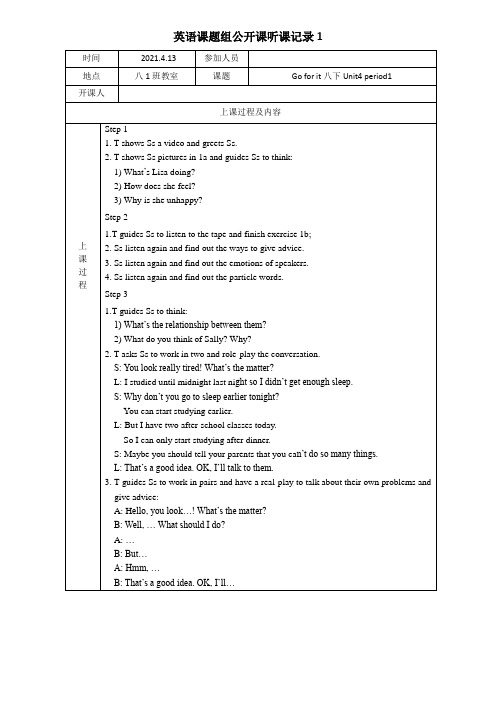
4. Ss listen again and find out the pes Ss to think:
1) What’s the relationship between them?
S: Why don’t you go to sleep earlier tonight?
You can start studying earlier.
L: But I have two after-school classes today.
So I can only start studying after dinner.
A:Hello, you look…! What’s the matter?
B: Well, … What should I do?
A:…
B: But…
A: Hmm, …
B: That’s a good idea. OK, I’ll…
评
课
记
录
XX老师:一节课课题的导入与该课的教学效果有着密切的联系。本节课老师为了激发学生对应于课堂内容的兴趣和拓展课堂信息的容量,老师利用了视频具有集图形、声音、动作为一体的特点,播放了一段视频,这一导入是根据既定的教学目标来精心设计的,没有游离于教学内容之外。但是导入的题目设得过大,在一定程度上使课堂听力时间显得局促;
S: Maybe you should tell your parents that you can’t do so many things.
L: That’s a good idea. OK, I’ll talk to them.
英语听课记录及课堂评价表
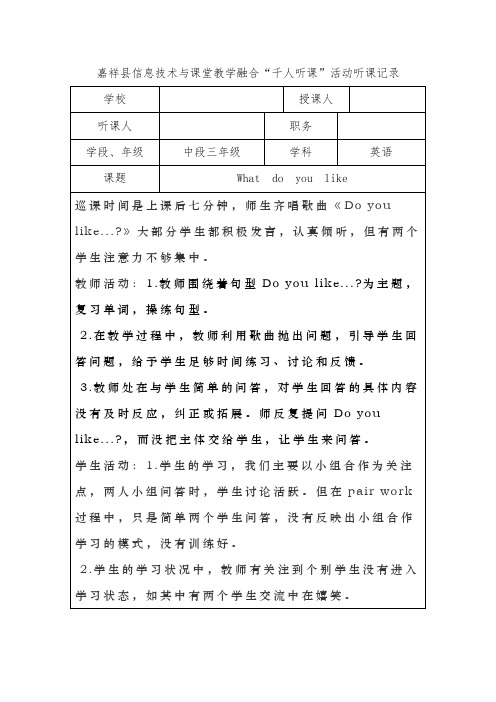
19
教
学
建
议
经过三年的英语学习,学生们掌握了一定的英语语言知识,初步形成了一定的听、说、读、写的能力,学习策略也得到了不同程度的发展,但是这也无形中拉开了学生之间的差异。因此在这一学年段应该更加有意识地进行分层次教学,不只在课堂教学中做到分层次,在作业和评估方面也可以尝试分层次,在各个方面多关注学习有困难的学生,避免差异的进一步扩大,努力做到面向全体。
2.在教学过程中,教师利用歌曲抛出问题,引导学生回答问题,给予学生足够时间练习、讨论和反馈。
3.教师处在与学生简单的问答,对学生回答的具体内容没有及时反应,纠正或拓展。师反复提问Do you like...?,而没把主体交给学生,让学生来问答。
学生活动:1.学生的学习,我们主要以小组合作为关注点,两人小组问答时,学生讨论活跃。但在pair work过程中,只是简单两个学生问答,没有反映出小组合作学习的模式,没有训练好。
嘉祥县信息技术与课堂教学融合“千人听课”活动听课记录
学校
授课人
听课人
职务
学段、年级
中段三年级
学科
英语
课题
What do you like
巡课时间是上课后七分钟,师生齐唱歌曲《Do you like...?》大部分学生都积极发言,认真倾听,但有两个学生注意力不够集中。
教师活动:1.教师围绕着句型Do you like...?为主题,复习单词,操练句型。
听课评价表年月日
授课教师
尹倩
科目
英语
本次题目
What do you like
听课教师
评价目标
评价要求
分值
得分
教学引入
1.课堂引入要简明、生动、具体,一语中的。
英语听课记录
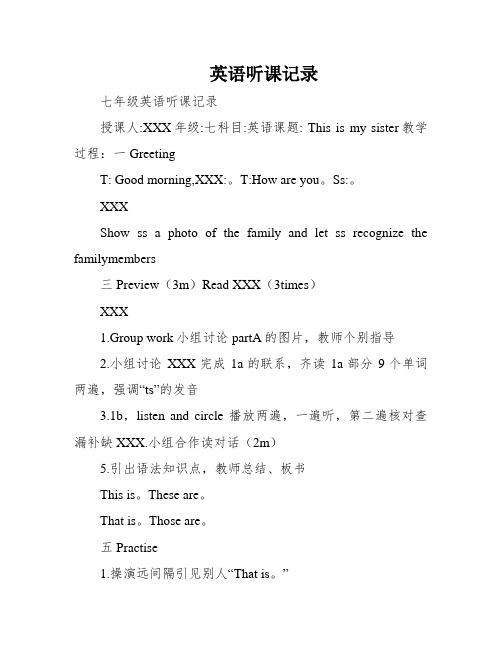
英语听课记录七年级英语听课记录授课人:XXX年级:七科目:英语课题: This is my sister教学过程:一GreetingT: Good morning,XXX:。
T:How are you。
Ss:。
XXXShow ss a photo of the family and let ss recognize the familymembers三Preview(3m)Read XXX(3times)XXX1.Group work小组讨论partA的图片,教师个别指导2.小组讨论XXX完成1a的联系,齐读1a部分9个单词两遍,强调“ts”的发音3.1b,listen and circle播放两遍,一遍听,第二遍核对查漏补缺XXX.小组合作读对话(2m)5.引出语法知识点,教师总结、板书This is。
These are。
That is。
Those are。
五Practise1.操演远间隔引见别人“That is。
”2利用那张家庭照片介绍家庭成员32a听力,circle the words you hear42b听力练5仿照2c组织对话(Group work)6.名词变复数(联合导学案操演)7.2d(Read XXX)8当堂测(联合导学案)六SummaryT:Can you introduce them?(the photo again).a girl)板书设计近间隔远距离让学生上讲台上展现进修的结果。
引见照片上的家庭成员(a boy &七HomeworkUnit 2Thisis。
mysisterThis is。
(单数)These。
are。
(复数)。
英语听课记录(完整版)
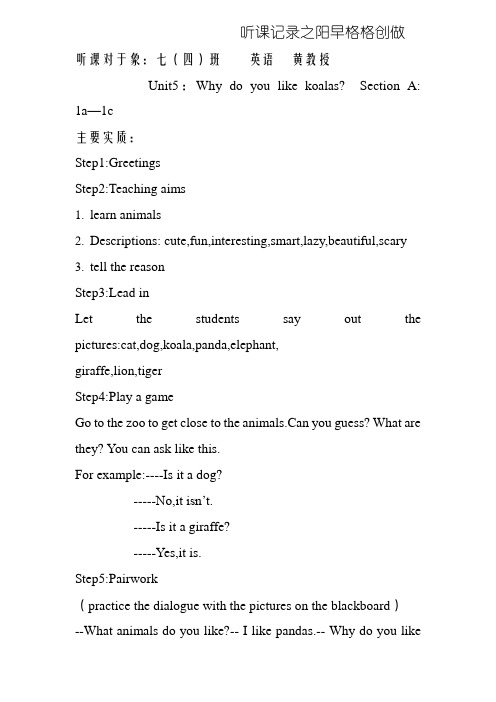
听课记录之阳早格格创做听课对于象:七(四)班英语黄教授Unit5:Why do you like koalas? Section A: 1a—1c主要实质:Step1:GreetingsStep2:Teaching aims1.learn animals2.Descriptions: cute,fun,interesting,smart,lazy,beautiful,scary3.tell the reasonStep3:Lead inLet the students say out the pictures:cat,dog,koala,panda,elephant,giraffe,lion,tigerStep4:Play a gameGo to the zoo to get close to the animals.Can you guess? What are they? You can ask like this.For example:----Is it a dog?-----No,it isn’t.-----Is it a giraffe?-----Yes,it is.Step5:Pairwork(practice the dialogue with the pictures on the blackboard)--What animals do you like?-- I like pandas.-- Why do you likepandas?-- Because they are cute. How about you?-- I like pandas ,too.-- Oh, let’s see the pandas first!-- That sounds good!-- OK. Let’s go!Step6:Do 1a(Match and read the dialogue)Step7:Listen 1bStep8:Read 1cStep9:Do the exerciseStep10:Make a conclusion.(Just as the teaching aims)1.Animals2.Descriptions: cute fun interesting smart lazy beautiful scary(a little=kind of very)3. Make a dialogue4. 沉面语法:▲ why----because▲let + V本形▲ kind of= a little 有面女▲ a kind of 一种▲ kinds of 多种百般的Step11:Learn more meaning from this lesson from a piture. (Animals are our friends.We should treat them well.---“Love animals ,Love ourselves!”)Step12:HomeworkRecite the words in this unit and do the exercise book in period 1.沉面取易面:1.沉面:The words of animals and descriptions(cute,fun,interesting,smart,lazy,beautiful,scary)2.易面:Pairwork(practice the dialogue with the pictures on the blackboard评:那堂课的教教中黄教授用的教法有:1.使用多媒介;2.创造有闭动物的卡片;3.用Pairwork的要领去训练对于话,进而进一步的掌握动物战形貌动物的形容词汇;4.训练题紧跟,即时坚韧本节所教知识面.便宜如下:1.备课严肃,准备充分;2.教法新颖,男女死PK末究;3.让教死去教堂前扮演Pairwork;4.师死互动、死死互动.缺面如下:1.针对于男女死PK,课尾最佳褒扬得胜圆;2表示动物的形容词汇练习缺累;3.容量便宜大,需要删减;4.教授有面拘谨,紧弛,需搁启面.。
英语english_听课记录表
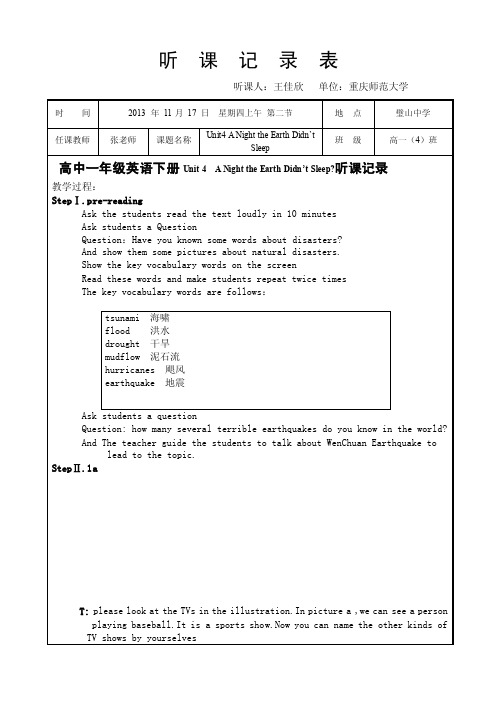
听课记录表听课人:王佳欣单位:重庆师范大学时间2013 年11月17 日星期四上午第二节地点璧山中学任课教师张老师课题名称Unit4 A Night the Earth Didn’tSleep班级高一(4)班高中一年级英语下册Unit 4 A Night the Earth Didn’t Sleep?听课记录教学过程:StepⅠ.pre-readingAsk the students read the text loudly in 10 minutesAsk students a QuestionQuestion:Have you known some words about disasters?And show them some pictures about natural disasters.Show the key vocabulary words on the screenRead these words and make students repeat twice timesThe key vocabulary words are follows:tsunami 海啸flood 洪水drought 干旱mudflow 泥石流hurricanes 飓风earthquake 地震Ask students a questionQuestion: how many several terrible earthquakes do you know in the world? And The teacher guide the students to talk about WenChuan Earthquake tolead to the topic.StepⅡ.1aT:please look at the TVs in the illustration.In picture a ,we can see a person playing baseball.It is a sports show.Now you can name the other kinds of TV shows by yourselvesMake a students read these words loudlyAt the same time ,write them on the blackboardStepⅢ.1bCall students attention to the words and smiling and frowning faces in the box.Play the recording the first time.Students only listenPlay the recording again.Students listen and write the letters of a TV show In each blank.Then.Check the answersAnswers:1.b2.a3.c4.d5.eTapescript:Jack: What do you think of soap operas,Mark?Mark: I don’t like them .Jack: What do you think of game shows ?Mark: I love themJack: What do you think of sitcoms?Mark: sitcoms?Mmm.I don’t mind them .Jack: What do you think of sports shows ?Mark: I like themJack: What do you think of talk shows ?Mark: talk shows ?I can’t stand them.StepⅣ.1cAllow students one minute to read the TV shows in 1a again .Invite a pair of students to read the sample conversation to the class .T:Please work in pairs .One student asks the question "What do you think of talk shows/sitcom ……"Get students to work in pairs .Ask several pairs to share their conversation with the class .StepⅤ.SummaryT:In this class ,we’ve learned names of some TV shows first ,which are talk Show,soap opera ,sports show ,sitcom and game show .Then we’ve done much Listening and oral practice using the target language What do you think of sitcoms? I love them .StepⅥ.HomeworkT:After class ,recite the spelling of the key words and the conversation in 1cStepⅦ.Blackboard Design下面是余秋雨经典励志语录,欢迎阅读。
英语专业实习听课记录簿15
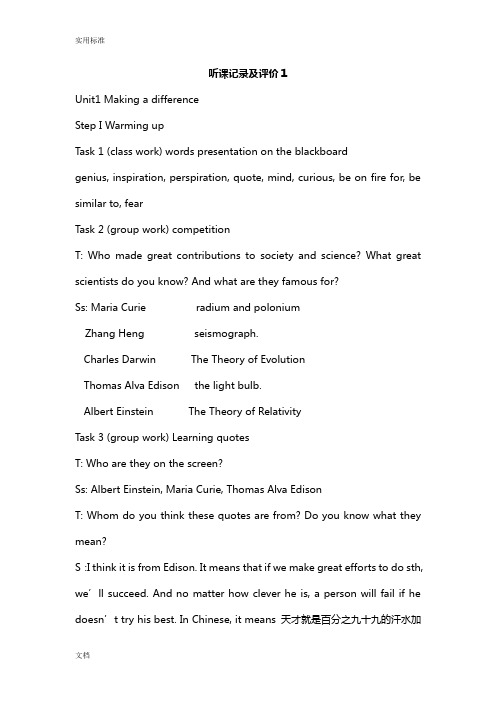
听课记录及评价1Unit1 Making a differenceStep I Warming upTask 1 (class work) words presentation on the blackboardgenius, inspiration, perspiration, quote, mind, curious, be on fire for, be similar to, fearTask 2 (group work) competitionT: Who made great contributions to society and science? What great scientists do you know? And what are they famous for?Ss: Maria Curie radium and poloniumZhang Heng seismograph.Charles Darwin The Theory of EvolutionThomas Alva Edison the light bulb.Albert Einstein The Theory of RelativityTask 3 (group work) Learning quotesT: Who are they on the screen?Ss: Albert Einstein, Maria Curie, Thomas Alva EdisonT: Whom do you think these quotes are from? Do you know what they mean?S:I think it is from Edison. It means that if we make great efforts to do sth, we’ll succeed. And no matter how clever he is, a person will fail if he doesn’t try his best. In Chinese, it means 天才就是百分之九十九的汗水加上百分之一的灵感。
